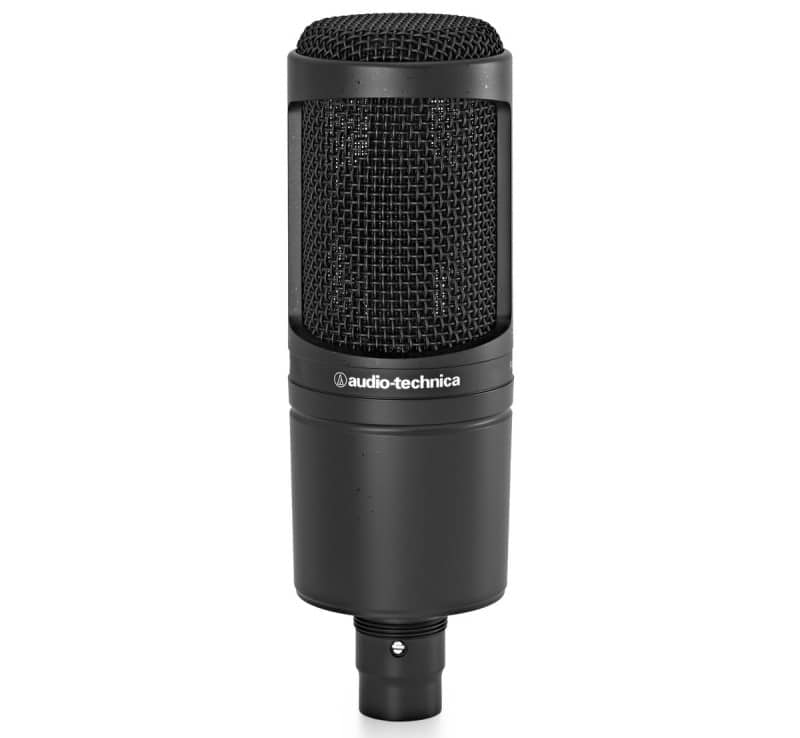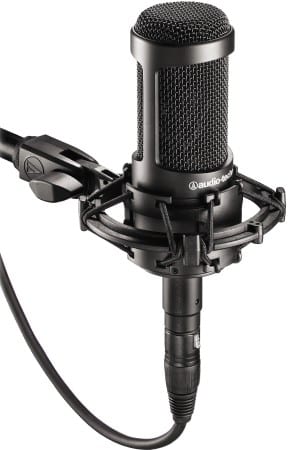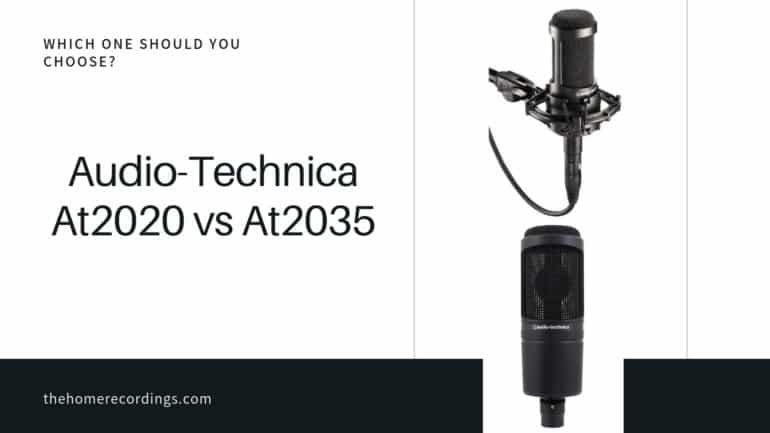Last updated on December 30th, 2023 at 02:53 pm
One very common question I see people ask all over the Internet is whether they should purchase the Audio-Technica AT2020 or the AT2035.
This is fair question simply because both of these microphones are so similar, however one of them is almost $50 more expensive.
So, in this post I’ll do my best to give you some good information about each microphone, their differences, and which one you should go for.
Let’s get straight into it.
Audio-Technica AT2020 vs AT2035
The Audio-Technica AT2035 has a flatter frequency response, giving it a more neutral sound which better represents how the source actually sounds, while the AT2020 has a slightly boosted mid- and high end which is designed to help the sources to better sit in the mix.
Audio-Technica AT2020

The AT2020 is a cardioid condenser microphone, which means that it is going to need phantom power in order to work properly (48v exactly), like all condenser microphones, however, 99.9% of audio interfaces supply phantom power, so if you get one that’s at least fairly recent then it should work with this mic.
Just like all the Audio-Technica microphones, the AT2020 is extremely well built.
When holding it in my hand it doesn’t feel like a cheap product at all, quite the opposite in fact.
However, since it’s a condenser microphone, I wouldn’t recommend dropping it and to keep it from taking an accidental beating since condenser microphones are a bit more sensitive than dynamic mics and could break, so keep this in mind.
The AT2020 can be used for a lot of different applications, such as;
Recording music, doing voice-over work, streaming, creating YouTube videos, and more.
Since the Audio-Technica AT2020 has a Cardioid pickup pattern, it will mostly be picking up sound from the front while rejecting sound from the back and the sides.
This is essential because you want to avoid picking up unwanted noises and any of the room’s natural sound, and a cardioid pattern will help with this quite a lot!
It has a frequency response of 20Hz-20kHz which is standard for almost every large diaphragm condenser microphone out there.
How does it perform?
The recording quality is great, especially since this microphone costs only about $100.
It has a slightly reduced low-end which I personally don’t like for the simple fact that ends up lacking a bit of “body”, plus I prefer to control this in post later on with EQ.
The slight boost to the mid-high frequencies can actually help your vocals better cut through the mix, but again, this is something you can do with EQ later on.
All in all, it’s a terrific mic to get if you’re on a budget!
What comes in the box?
- The Audio-Technica AT2020 Mic
- A storage Pouch
- Microphone Clip
Features
- Great Build quality
- High SPL handling and wide dynamic range provide maximum versatility
- Cardioid polar patter which reduces the overall noise picked up
- 144 dB SPL Handling
Specifications
| Polar Pattern | Cardioid |
| Microphone type | Condenser |
| Frequency Response | 20 to 20,000 Hz |
| Output Impedance | Rated impedance is 100 Ohms |
| Connector | Three-pin (XLR), male |
| Max SPL | 144dB SPL |
| Sensitivity | -37dB |
| Self-Noise | 20dB |
Find out more about the Audio-Technica AT2020 here:
- Audio-Technica AT2020: Amazon, Sweetwater.
Audio-Technica AT2035

Just like all the other AT20’ series, the AT2035 has a great Build quality, pretty much identical to the one of the AT2020.
The body and the grille are all metal and it really does feel like a good microphone.
One difference between the AT2020 and this one is that it comes with a -10dB PAD as well as a high-pass filter.
Not only that, but when looking at the sensitivity you’ll notice that it has a louder output signal.
This means that you won’t need to drive the preamps on your Interface as much, yielding a cleaner signal, and it also has a lower self-noise.
The shock mount, which comes included is made out of plastic but it gets the job done and it’s also very durable, so no worries there.
Apparently, the AT2035 is modelled after the AT3035 (A mic which I currently Own and that just sounds fantastic), which has now been discontinued.
The only differences are a couple of the electronics and the color of the mics themselves, AND that the AT3035 used to sell for around $350!
Other than that, both the AT2035 and the AT3035 are the same.
Just like the AT2020, The AT2035 is a cardioid condenser microphone, which means that it is going to need phantom power in order to work properly.
Now, here’s another point where both these mics differ; The AT2020 requires 48v of phantom power while the AT2035 requires 11-52v.
Now, I’ve read on some websites that you don’t really need an Interface to be able to use the AT2035 or the AT2035, and while you could certainly use a phantom power supply and then connect the mic to your computer via an XLR/TRS mini cable, it’s not the ideal way since the analog to digital conversion will be done by your PC’s soundcard instead of a dedicated audio interface.
Most Audio Interfaces are super affordable though and you can even get some pretty good ones for under $70.
Here’s a post about two very inexpensive Audio Interfaces, however I’d recommend going with something a little more powerful.
Here’s a list of posts I wrote about great and budget-friendly audio interfaces:
- Best Audio Interfaces under $300
- Scarlett 2i2 vs UMC204HD (Higher quality and affordable)
- Scarlett 6i6 vs UMC 404HD (A bit more expensive but very cost-efficient)
Moving on…
How does it Perform?
The sound quality is much better than the AT2020 in my opinion.
It sounds great when recording vocals or doing anything voice-related, as well as when recording acoustic guitars.
When mic’ing up guitar cabinets, on the other hand, I found it to sound a bit muddy, but this isn’t anything that can’t be fixed in post by adding a high-pass filter, or even by engaging the one on the mic, so no worries there.
The AT2035 sounds flatter than the AT2020 and this is always a pro since it gives you the option to better tweak everything in post.
Plus, since it doesn’t have an artificially reduced low-end, like the AT2020 does and everything sounds way more natural to me.
And if you ever want to reduce the low-end, you can simply engage the HPF on the mic or add it in post in your DAW.
Essentially, the AT2035 gives you a more accurate representation of how the instrument/performance actually sounds.
What comes in the box?
- Audio-Technica AT2035 Microphone
- Shock Mount
- Carrying Pouch
Features
- Durable Build
- -10dB PAD
- High-Pass Filter
- No Artificially reduced low-end
Specifications
| Polar Pattern | Cardioid |
| Microphone type | Condenser |
| Frequency Response | 20 to 20,000 Hz |
| Output Impedance | Rated impedance is 120 Ohms |
| Connector | Three-pin (XLR), male |
| Max SPL | 148 or 158 dB SPL (With PAD) |
| Sensitivity | -33dB |
| Self-Noise | 12dB |
Find out more about the Audio-Technica AT2035 here:
- Audio-Technica AT2035: Amazon, Sweetwater.
Which one should you choose?
To be honest, the only reason I would choose the Audio-Technica AT2020 is if I didn’t have the budget to purchase the AT2035.
The reason for this is that, not only do you get the added High-Pass filter and PAD switches when purchasing the AT2035, but it’s also a different microphone in itself and sounds fuller and more natural.
And even though it sells for about 50% more than the AT2020, it’s definitely one of those mics that you won’t need to upgrade from for a long time, or ever.
I know that having a High-Pass filter on the mic itself isn’t anything too essential, but if you need to use multiple mics and you need a hpf engaged, then it’s far easier simply flick a switch and be done with it than having to go through each track setting one up.
Having said all of that, the AT2020 is still a fantastic mic for the price, but the AT2035 is just a better microphone overall, even while being more expensive.
Conclusion
If you can, go with the AT2035.
I promise you it’s a much better mic and you won’t be disappointed.
Still, if you only have the budget for the AT2020, or if you need to get an Audio Interface which is going to add to the overall cost, then by all means, go with the AT2020.
Here are some links to both microphones again:
- Audio-Technica AT2020: Amazon, Sweetwater.
- Audio-Technica AT2035: Amazon, Sweetwater.
I hope this information was useful!
Have a wonderful Day!

Very useful info. I am looking into Voice Over work for the beginner and Amazon sells both mics.